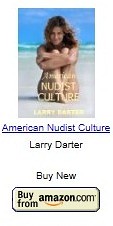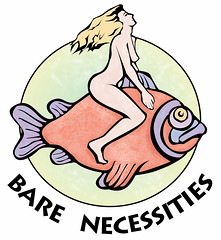 In contemporary American society, social nudity is not accepted by the majority of people. In all 50 states, strict laws prohibiting nudity in public places exist with very few exceptions. Those exceptions typically include when social nudity occurs on private property like privately owned “nudist resorts” or on slivers of well-delineated public land designated to be “clothing-optional,” such as small sections of public beaches.
In contemporary American society, social nudity is not accepted by the majority of people. In all 50 states, strict laws prohibiting nudity in public places exist with very few exceptions. Those exceptions typically include when social nudity occurs on private property like privately owned “nudist resorts” or on slivers of well-delineated public land designated to be “clothing-optional,” such as small sections of public beaches.Today I am beginning a five part article, divided in this way because it is rather lengthy and I think would be asking too much of you to read it in its entirety in one setting. Today I will introduce the topic, Shock and Awe: A Strategy, and then will publish the remaining four installments which take the topic to greater depths, over the course of the next week or so.
I spend a good deal of time contemplating why it is that nudism, which first appeared here in 1929, has had such a difficult and arduous struggle in gaining more widespread acceptance as a part of mainstream culture in this country. A part of that of course is the simple fact that nudity remains a taboo in America because the majority still primarily equates nudity or nakedness with sexuality and we have taboos about sexuality. A lot of that mindset, I think is attributable to our Puritan and Victorian heritage. Still I find myself somewhat mystified by the continued intolerance that the concept and practice of social nudity still garners on many fronts. The fact that so many Americans are still severely bothered by nakedness seems to me to be quite inexplicable and well, bizarre.
Yes, certainly I do understand that much of the anxiety that many people suffer at the thought of either being seen nude or seeing others nude may stem from general anxiety about sexuality, from fears that they are physically inferior (negative body image), from a fear that nakedness leaves them exposed and unprotected and the fact that so many people have been indoctrinated into the media driven idea that to be acceptable one must be ultra buff, stick thin, have large boobs and perfect hair. The pressure to attain the mythical “perfect body” explains much about why people not only suffer from lack of self-acceptance and poor body image, but why they also reject so vigorously the idea of being subjected to seeing other “imperfect” bodies in the nude.
The still ultra-conservative standards of modesty in our society that generally prevent public nudity truly eclipse any concept of mere demureness or reticence, actually manifesting a standard that more accurately is termed prudishness or body shame.
Never content with only contemplating and analyzing the problem of widespread societal intolerance of social nudity, I find myself also speculating on where we naturists and nudists may have fallen short in our attempts to get our message across to our textile neighbors. We continually bemoan the issue of linkage between social nudity and sex, the pervasive misconception most us hold as the biggest problem we struggle against, but have we really done enough to counter it? Have we presented the facts about naturism and nudism effectively enough to have any realistic expectation of changing anyone’s mind about it? Have we shown ourselves openly enough to the rest of society as people for us to reasonably expect they can see us as normal, rational, intelligent members of society who simply enjoy spending time nude in nature and in communal settings with other like-minded people?
Candidly, I think we have fallen short in all of those areas. Since its infancy, the nudist movement in this country has been for the most part relegated to a practice that takes place behind the walls of those privately owned “nudist resorts.” Yes there have been notable exceptions, like the “free-beach movement” but truly those are the exception and not the rule and their occurrence have been few and far between. Keeping social nudity veiled in secrecy behind the walls of privately owned clubs and resorts smacks of a “fortress” mentality and has not been a very effective strategy for taking our arguments to the general public. Throughout history, whenever there has been a fortress, be it literal or figurative, it has always followed that someone, somewhere invariably becomes convinced that there is the need to lay a siege. I think if we allow ourselves to feel comfortable and accept the current status quo, what we will find is that the precious few rights we have now as naturists and nudists will never expand but are much more likely to erode. Having spoken to a good number of private nudist resort owners, I have been told by several about attempts on the part of local governments to characterize nudist resorts as “adult businesses.” If they are ever successful in doing so, it would subject resorts to such restrictive rules and regulations that it would indeed serve as a death knell and would make it untenable for them to continue to operate.
It is often said that in football, defense wins championships but for the community of naturists and nudists, I think we have been on the defense for far too long. Like many famous generals have observed, often the best defense is a good offense. Perhaps it is time for naturists and nudists to borrow the strategy popularized and orchestrated so effectively by General Norman Schwarzkopf in Operation Desert Storm, “Shock and Awe.” In that context of course, “Shock and Awe” had to do with the application of overwhelming air superiority and the use of surgically precise guided munitions and is obviously not what I’m suggesting here. But believe it or not, with some creative and innovative thought I do believe it possible for naturists and nudists to effectively and efficiently employ many of the concepts in a similar strategy in our fight for respectability, tolerance and mainstream acceptability.
Allow me to dissect the strategy “Shock and Awe” reducing it to the lowest common denominator and then to explain how this strategy might be employed by those who embrace social nudity as a normal and natural way of life. In a nutshell, Shock and awe, also known as rapid dominance, is a military doctrine based on the use of overwhelming power, dominant battlefield awareness, dominant maneuvers, and spectacular displays of force to paralyze an adversary's perception of the battlefield and destroy its will to fight. Let us examine how we might employ similar concepts on our own “battlefield.” Make no mistake; it is a battle we are engaged in. There are not only those who openly disapprove of nudists but those who are actually hostile to nudism and are willing to actively resist social nudity with every means at their disposal.
Next Installment - Shock and Awe Part 2: Overwhelming Power







I'm quite excited about the next four parts! I agree with you thus far, but I'm curious as to how practical your idea might be.
ReplyDeleteIt's good to see academic articles and new challenging viewpoints from other nudist bloggers. Keep up the great work!
I'm looking forward to the rest of the series.
ReplyDeleteThere needs to be more openness and candidness among individual nudists and naturists about the lifestyle on a grassroots level. I've seen numerous articles and commentary in N magazine and The Bulletin recently calling on nudists be more open about their nudist experiences and to promote nudism.
You've been posting a lot of great articles here, keep up the good work.
It's about time, I just hope that we get off our fat ***** and actualy do something. Nude is normal so accept it.
ReplyDelete